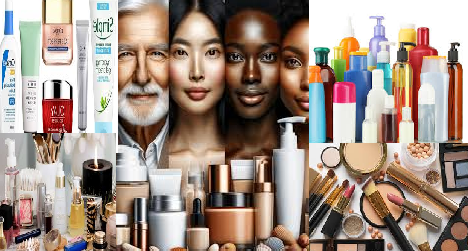Major Myths About Cosmetics and The Real Facts. Part #02

Major Myths About Cosmetics and The Real Facts.
#01 Myth:
Makeup causes acne.
Fact:
Probably not.
- There is no research indicating that makeup or skin-care products cause acne, and there is no consensus on which ingredients are problematic.
- In the late 1970s, there was some research performed on rabbit skin using 100% concentrations of ingredients to determine whether or not they caused acne.
- Subsequently, it was determined that this study had nothing to do with the way women wear makeup or use skin-care products, and it was never repeated or considered useful in any way.
- Still, women do experience breakouts after using some skincare or makeup products (or a random combination of both I know I do).
- Such breakouts can be the result of an irritant or an inflammatory response, a random skin reaction, or a result of problematic ingredients unique to a person’s skin type.
- That means you have to experiment to see what might be causing your
- There is no information from medical research or the cosmetics industry to help or point you in the right direction.
- And just so you know, “non-comedogenic” is a meaningless word the cosmetics industry uses to indicate that a product is less likely to cause breakouts.
- The problem is no standards or regulations have been set up to describe this category.
#02. Myth:
Stress causes acne.
Fact:
Generally, it is believed that stress can trigger acne, but no one is exactly sure how that works, and there is conflicting research.
- While it never hurts to reduce angst and worry in your life, stress as a causative factor for acne is hard to pinpoint.
- Plus, the way to treat acne doesn’t change because of the stressors in your life.
#03. Myth:
Toothpaste works to prevent or quickly heal a pimple.
Fact:
Absolutely not true
- This would be funny if so, many people didn’t believe it.
- None of the ingredients in toothpaste can have a positive effect on acne or change a blemish once you have it, and it can make matters worst.
- The bacteria in your mouth are not related to the bacteria ( acnes) in your pores that cause acne.
- Although the fluoride or sodium monofluorophosphate in your toothpaste can help fight bacteria in your mouth, and on your skin, they can cause pimples and redness in the areas they come in contact with.
- This is known as perioral dermatitis
- The other ingredients in toothpaste might have minimal abrasive properties, but they provide nothing that a gentle rubbing with a washcloth can’t do far better.
- Another issue for the skin is that the flavorings added to toothpaste present additional problems that you should avoid on your skin.
#04. Myth:
Applying collagen and elastin to the skin will add to the collagen and elastin content of the skin, which will eliminate wrinkles.
Fact:
Collagen and elastin in skin-care products can serve as good water-binding agents, but they cannot fuse with your skin’s natural supply of these supportive elements.
- In most cases, the collagen molecule is too large to penetrate the skin.
- But even when it is made small enough to be absorbed it cannot bind with the collagen existing in the skin, and there isn’t a shred of research indicating otherwise.
- What does exist are myriad studies showing that collagen is a very good moisturizing ingredient, which is great for skin, but it is neither unique nor the only formulary option.
- It is important to point out that even if you were to take the collagen that is used in medically administered dermal injections and rub it on your skin, it wouldn’t be absorbed, and it wouldn’t change wrinkles by bolstering the existing collagen.
- There is even less research showing that elastin has any benefit when applied topically.
- Keep in mind that even if collagen or elastin could be absorbed, and even if they could combine with your existing collagen or elastin, without guidelines you would just keep adding collagen and elastin to your skin, and eventually it would stick out in places you wouldn’t want it to, stick out in lumps if too much was absorbed in one place, and plump up your fingers because that’s what you use to apply the product that contains these ingredients.
- When a physician uses collagen injections to plump up lips and lines on the face, he or she can inject only so much collagen into your face before you end up with overblown lips and a distorted facial expression.
- Protecting your skin from sun damage, daily exfoliation with a well-formulated AHA or BHA product, and treating your skin to a range of ingredients (antioxidants, cell-communicating ingredients, and skin-identical ingredients) that it needs to look and feel its best will protect its natural collagen supply and allow it to build new collagen something healthy, protected skin loves to do and does quite well.
#05. Myth:
Eye creams are specially formulated for use around the delicate eye area.
Fact:
There is no evidence, research, or documentation validating the claim that the eye area needs ingredients different from those you use on your face, neck area, or décolletage.
- Even if there were ingredients that were special for the eye area, that aren’t evident on the labels for eye-care products; their formulations seem to be chosen at random, with no consistency in the industry.
- All cosmetics companies put whatever ingredients they want into their eye products.
- Typically, they give you half as much but charge you twice as much as the same product being sold for your face.
- The ingredient labels on these “specialty” products more than prove the
- Eye creams are a whim of the cosmetics industry designed to evoke the sale of two products when only one is needed.
One more point:
- Occasionally a physician, aesthetician, or someone selling skin-care products will defend their eye creams by telling me that the eye area doesn’t need ingredients that irritate.
- Well, I agree wholeheartedly with that statement, but the same is true for the face, or anywhere else on your body.
- You shouldn’t be applying formulations with needlessly irritating ingredients period.
- That means that all your eye area needs are a well-formulated product, and that can certainly be the same product you use on your face.
#06. Myth:
There is (or will be) a product out there that really can eliminate wrinkles.
Fact:
Regrettably, there is no magic potion or combination of products in any price range that can make wrinkles truly disappear, or prevent them, except daily use of a well-formulated sunscreen (and never getting a tan).
- The wrinkles you see and agonize over (not to be confused with fine lines caused by dryness, which are easily remedied with a good moisturizer) are the result of cumulative sun damage and the inevitable breakdown of your skin’s natural support structure.
- Skin-care ingredients, no matter who is selling them or what claims they make for them, cannot replace what plastic surgeons and cosmetic dermatologists do.
- There are thousands of anti-wrinkle products being sold and we buy more of them than almost any other beauty products.
- Yet as I stated before, despite this onslaught of products, plastic surgeons and dermatologists are not going out of business.
- An interesting study in Skin Research and Technology (May 2007, pages 189–194) compared the effects of an inexpensive moisturizing face cream with an expensive one in a luxurious jar,
- Eighty Swedish women aged 35–64 years were randomly divided into three groups:
- Group A treated their facial skin for six weeks with the expensive cream in its luxury jar,
- Group B used an inexpensive moisturizer presented in the same luxury jar,
- Group C used the expensive cream contained in a neutral jar.
- The evaluations were made by the subjects, by a clinically trained observer, and by measuring the skin surface relief using optical profilometry (a method that measures the contours and roughness of surface skin).
- All the results showed no differences between the three groups related to the effects on wrinkles and smoothness, and there was no assessment of their skin feeling younger or more beautiful.
- Facial appearance was the same and profilometry showed reduced surface microrelief with all the products.
- Don’t take this to mean that there aren’t skin-care products that can significantly help improve skin, because there are, including sunscreen, exfoliants (AHAs or BHA), moisturizers loaded with antioxidants and cell-communicating ingredients, retinoids (components of Vitamin A), and numerous others.
- It’s just that anti-wrinkle skin-care products can’t perform according to the exaggerated claims on the label.
- After all, if they worked as promised then cosmetics companies wouldn’t be launching new anti-wrinkle products every few months.
#07. Myth:
Expensive cosmetics are better than inexpensive cosmetics.
Fact:
The absolute truth is that there are good and bad products in all price categories.
- The amount of money you spend on skin-care products has nothing to do with the quality or uniqueness of the formula.
- An expensive soap by Erno Laszlo is no better for your skin than an inexpensive bar soap such as Dove (though I suggest that both are potentially too irritating and drying for all skin types).
- On the other hand, an irritant-free toner by Neutrogena can be just as good as, or maybe even better than, an irritant-free toner by Orlane or La Prairie (depending on the formulation), and any irritant-free toner is infinitely better than a toner that contains alcohol, peppermint, menthol, essential oils, eucalyptus, lemon, or other irritants, no matter how natural-sounding the ingredients are and regardless of the price or claim.
- I’ve seen lots of expensive products that are little more than water and wax, and inexpensive products that are beautifully formulated.
- And in all price ranges, I’ve seen products come in jar packaging, which is like throwing your money away since jar packaging can’t keep important, air-sensitive ingredients such as antioxidants stable.
- Spending less doesn’t hurt your skin, and spending more doesn’t help It’s all about the formulation, not the price.
#08. Myth:
European products, especially from countries like France, Switzerland, and Italy, are formulated better than products from other countries. European women just know how to take care of their skin.
Fact:
According to a researcher, having spent a good deal of time in Europe doing presentations to women about skincare and reviewing European cosmetic brands I can say without hesitation that is utterly not true.
- The facts are on the ingredient label and European products have all the same problems that cosmetic products have all over the world, including jar packaging, which doesn’t keep air-sensitive ingredients such as plant extracts, vitamins, and many cell-communicating ingredients stable after opening; the use of irritating ingredients or overly drying ingredients; antiquated formulations; and overpriced concoctions that are little more than just wax and water.
- None of that creates superlative skin care by any definition.
- The other notion, that European women take better care of their skin, is a strange ongoing myth.
- Although European women are not as overweight as American women (actually no country in the world has a bigger obesity problem than the S., but that’s another discussion), they do not take better care of their skin.
- They smoke, they tan, they use poorly formulated products, and they believe the same false claims women all over the world get sucked into believing.
#09. Myth:
Natural ingredients are better for the skin than synthetic ingredients.
Fact:
Whatever preconceived notion someone might have about natural ingredients being better for the skin, or whatever media-induced fiction someone might believe, this is not true.
- There is no factual basis or scientific legitimacy for the belief that natural is better.
- Not only is the definition of “natural” hazy but the term is loosely regulated, so any cosmetics company can use it to mean whatever they want it to mean.
- Just because an ingredient grows out of the ground or is found in nature doesn’t make it automatically good for the skin, and the reverse is also true:
- Just because it is synthetic doesn’t make it bad.
- Consumers should not necessarily assume that an ‘organic’ or ‘natural’ ingredient or product would possess greater inherent safety than another chemically identical version of the same ingredient,” Linda M. Katz, director of the Food and Drug Administration’s Office of Cosmetics and Colors stated.
- “In fact, ‘natural’ ingredients may be harder to preserve against microbial contamination and growth than synthetic raw materials”
- But people should not interpret even the USDA Organic seal or any organic seal of approval on cosmetics as proof of health benefits or of efficacy, said Joan Shaffer, USDA spokeswoman
- The National Organic Program is a marketing program, not a safety program.
- Steak may be graded prime, but that has no bearing on whether it is safe or nutritious to eat.
#10. Myth:
Packaging doesn’t matter when it comes to skin-care products; I just love products that come in beautiful containers, especially jars.
Fact:
Packaging plays a significant role in the stability and effectiveness of the products you use.
- Because many state-of-the-art ingredients, from cell-communicating ingredients, antioxidants, and plant extracts to skin-identical ingredients, are unstable in the presence of air, jar packaging, once opened, permits air to enter freely, which causes these important ingredients, the very ingredients that make a product most beneficial for skin, to break down and deteriorate.
- Jars also mean you are sticking your fingers into the product, which can transfer bacteria and further cause the great ingredients to break down.
- Think about how long an unprotected head of lettuce lasts in your refrigerator.
- Or after opening a can or jar of food, how long does it take before becoming a moldy mess?
- Airtight packaging, or any packaging that reduces the product’s exposure to air, is essential when you are buying the best products for your skin.
- You should also avoid clear packaging that lets light into the product.
- Light of any kind is a problem because it causes sensitive ingredients to break down.
- If that isn’t enough to make you reconsider jar packaging, it’s worth noting that The Guidelines on Stability of Cosmetic Products, March 2004, by the CTFA and COLIPA (respectively, the American and European cosmetic governing associations most cosmetic companies in Europe and the US belong to) states;
- “Packaging can directly affect finished product stability because of interactions that can occur between the product, the package, and the external environment.
- Such interactions may include… Barrier properties of the container [and] its effectiveness in protecting the contents from the adverse effects of atmospheric oxygen….”






